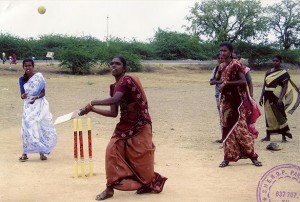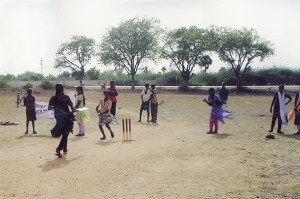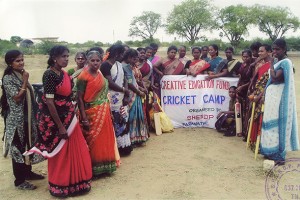In 2004, Hesperian Health Guides had a grant-making project, the Creative Education Fund, through which small, one-time grants were given to community-based groups wanting to do health education projects that would benefit women. The story that follows highlights the inspiring work of one Creative Education Fund grant recipient.
 The Society for Health Environmental and Rural Development Project (SHERDP) is a grassroots organization working in the rural district of Namakkal in Tamil Nadu, India. In 2004 SHERDP applied for a small grant from Hesperian’s Creative Education Fund to support a project that showed women how to work together to stand up for their rights to get health services.
The Society for Health Environmental and Rural Development Project (SHERDP) is a grassroots organization working in the rural district of Namakkal in Tamil Nadu, India. In 2004 SHERDP applied for a small grant from Hesperian’s Creative Education Fund to support a project that showed women how to work together to stand up for their rights to get health services.
In the area of Namakkal there was a government health clinic with a doctor and nurse who were supposed to provide medical services to the local people. However, the doctor and nurse seldom showed up and treated people badly when they did, and the women stopped going. SHERDP wanted women to have access to health services, and the organization decided to go about building empowerment for women in a very unique way.
 SHERDP’s project began by first holding “Cricket Camps” for women in the 10 villages the clinic was supposed to serve. 200 women were taught how to play cricket, a bat-and-ball team game that is the most popular sport in India. Cricket players from a local college volunteered to train and coach the women and act as umpires during games, and once a week they explained any weaknesses they saw and gave further training on collective team work to improve skills. Each team had to learn to work together to score more runs to beat the other team. SHERDP saw this as a way to show the women the importance of collective action and strategic planning, although the women themselves thought they were just learning a game and having fun. From time to time, the teams were reorganized so that all 200 women learned how to play the game with each other.
SHERDP’s project began by first holding “Cricket Camps” for women in the 10 villages the clinic was supposed to serve. 200 women were taught how to play cricket, a bat-and-ball team game that is the most popular sport in India. Cricket players from a local college volunteered to train and coach the women and act as umpires during games, and once a week they explained any weaknesses they saw and gave further training on collective team work to improve skills. Each team had to learn to work together to score more runs to beat the other team. SHERDP saw this as a way to show the women the importance of collective action and strategic planning, although the women themselves thought they were just learning a game and having fun. From time to time, the teams were reorganized so that all 200 women learned how to play the game with each other.
 After 9 months of cricket the social education began. The women were told about the social concepts and analysis derived through the game. The stumps represented the goal: the services of the existing government health clinic. The batsman in front of the stumps represented the people with vested interests who were denying the rural poor access to the clinic. The bowler represented the women and their attempts to reach the goal – knocking down the stumps. But the batsman – the vested interest – blocks the attempt. Then the fielders – the women on the team– worked together and foiled the batsman’s effort to score over the bowler.
After 9 months of cricket the social education began. The women were told about the social concepts and analysis derived through the game. The stumps represented the goal: the services of the existing government health clinic. The batsman in front of the stumps represented the people with vested interests who were denying the rural poor access to the clinic. The bowler represented the women and their attempts to reach the goal – knocking down the stumps. But the batsman – the vested interest – blocks the attempt. Then the fielders – the women on the team– worked together and foiled the batsman’s effort to score over the bowler.
SHERDP discussed with the women how they could use what they had learned as a team to fight collectively for their rights, and about the health care services they were legally entitled to. They practiced and did role-plays together about how they might go to the clinic to demand these services. With their new-found confidence, the women confronted the doctor and nurse of the clinic, telling them they knew Ministry of Health laws require the clinic to be open and staffed on a regular basis, and that they would be reported if it wasn’t. Their team effort was a success; the staff of the clinic listened to the women and opened the clinic during the required hours.
Recently, Hesperian checked in with SHERDP for an update on this project. While the women are no longer playing cricket, the clinic remains open in the day and evening hours, serving the women of Namakkal and their families.





